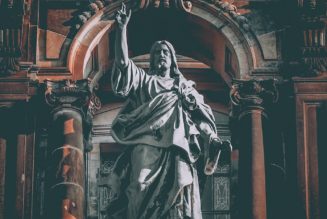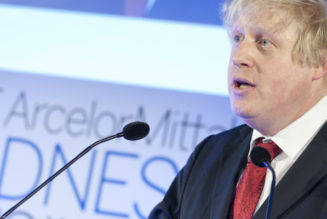 For most people, the name of Sir Alec Guinness is associated with his playing of Obi-Wan Kenobi in the original Star Wars trilogy. Such an association is understandable enough but it does scant justice to Sir Alec’s true legacy as one of the greatest actors of the twentieth century. He was a fine Shakespearean actor, standing shoulder to shoulder with Sir Laurence Olivier and Sir John Gielgud as the most illustrious and successful of those who made the transition from stage to film in the years following World War Two.
For most people, the name of Sir Alec Guinness is associated with his playing of Obi-Wan Kenobi in the original Star Wars trilogy. Such an association is understandable enough but it does scant justice to Sir Alec’s true legacy as one of the greatest actors of the twentieth century. He was a fine Shakespearean actor, standing shoulder to shoulder with Sir Laurence Olivier and Sir John Gielgud as the most illustrious and successful of those who made the transition from stage to film in the years following World War Two.
Prior to the war, he had made his way up through the billing, from minor roles, such as Osric in Hamlet, which he played as a twenty-year-old in 1934, to playing the role of Hamlet himself in 1938 and Macbeth the following year. Throughout his life, he continued to appear on stage, never forsaking his thespian roots even as he became a major star of the silver screen.
Sir Alec’s first film roles found him switching from Shakespeare to Dickens. He appeared in Great Expectations in 1946 and Oliver Twist in 1948, his performance as Fagin in the latter being a triumph. Both these films were directed by David Lean, beginning a fruitful collaboration. Other Lean-directed films in which Sir Alec appeared were Lawrence of Arabia, Doctor Zhivago, A Passage to India and most especially The Bridge Over the River Kwai, for which he won both the Academy Award and the BAFTA Award for best actor.
Apart from the gravitas exhibited in these Lean-directed roles, Sir Alec also showed a great gift for levitas in several successful comedies produced by the London-based Ealing studios between 1949 and 1957, including The Lavender Hill Mob, for which he received his first Academy Award nomination, and Kind Hearts and Coronets, in which he played no fewer than nine different characters.
One of the most intriguing of the Ealing Comedies in which Sir Alec starred is The Man in the White Suit in which he plays a scientist who invents what appears to be an indestructible fibre. The film, beneath the rambunctious surface, is a powerful political satire in which capitalist factory owners unite with their erstwhile socialist enemies to prevent a new technology which would potentially be bad for business and for the livelihood of workers. Watching the film today, from the perspective of our technophilic culture, provides a techno-skeptical counterpoint to the contemporary optimism of scientism and suggests a “third-way” approach to political and economic problems beyond myopic Marxism and laissez-faire libertinism. Released in 1951, in the looming presence of the Cold War and the Bomb, The Man in the White Suit is a manifestation in comic form of the gritty Orwellian realism of the post-war years which transcended socialist-versus-capitalist reductionism.
In 1954, Sir Alec played the role of G. K. Chesterton’s priest-detective in Father Brown, an experience which would prove pivotal on his path to Rome and catalytic with respect to his conversion, precipitating his reception into the Catholic Church two years later. In the interim, in 1955, he starred as the Cardinal in the film The Prisoner, which was presumably inspired by and based on the life and persecution of Cardinal Mindszenty in Hungary, who was imprisoned by the communists at the time the film was made, having been previously imprisoned by the Nazis. (In 1972, Sir Alec would complete his ascent through the Catholic hierarchy from priest, to cardinal to holy pontiff, when he was cast to play Pope Innocent III in Franco Zeffirelli’s controversial Brother Sun, Sister Moon.)
Having played Catholic priests in two consecutive years, Sir Alec’s newfound beliefs were finding creative expression in the parts he chose to play. In the years ahead, he would star in film adaptations of some of the greatest works of the Catholic cultural revival of which he was now an integral part. He starred in adaptations of Graham Greene’s novels, Our Man in Havana and Monsignor Quixote, in 1959 and 1987 respectively, and in the adaptation of Evelyn Waugh’s novel, A Handful of Dust, in 1988. Surprisingly perhaps, he was not cast to appear in the 1981 adaptation of Waugh’s masterpiece, Brideshead Revisited, which featured Sir Laurence Olivier and Sir John Gielgud, two of a very few who could be considered Sir Alec’s equals in terms of genius.
As a brief postscript to this tribute to the life and legacy of Sir Alec Guinness, the present author would like to mention his own “brief encounter” with the great man. It began in very unpropitious circumstances, when I received a letter from Sir Alec’s agent, informing me that I had quoted too extensively in my book Literary Converts from Sir Alec’s autobiography, Blessings in Disguise. The extent of my direct quotation was beyond that considered “fair use” which meant that I was liable to pay Sir Alec for the use of his copyrighted words. Mortified, I took a look at the chapter in my book which focused on Sir Alec’s conversion and could see instantly that it was based almost exclusively on Sir Alec’s own account in his own book, much of which was quoted verbatim. What could I do but confess my crime? As directed, I sent a cheque for the princely sum of £100 to the agent, adding my profuse apologies. It hurt in more ways than one. My pride was hurt for the faux pas I’d committed, and my bank balance was hurt by the removal of the precious funds. This was in late 1999 or early 2000. I was struggling to make ends meet as a fulltime writer and could ill afford to part with such money. Chastened, I hastened to write the next book all the sooner to keep a roof over my head. Imagine my surprise, a few weeks later, when I received a letter from Sir Alec himself, informing me that he had very much enjoyed reading my book and that he could not possibly accept the cheque I had sent him, which he had returned, neatly snipped in half with scissors. What is one to say of such a charming act of generosity from an old man who was dying of cancer and would breathe his last only a few months later?
Perhaps the last word should be left to Sir Alec Guinness himself. “Much water has flown under Tiber’s bridges,” he wrote in Blessings in Disguise, “carrying away splendour and mystery from Rome, since the pontificate of Pius XII:
The principles, I know, remain firmly entrenched…. The Church has proved she is not moribund. ‘All shall be well,’ I feel, ‘and all manner of things shall be well,’ so long as the God who is worshipped is the God of all ages, past and to come, and not the Idol of Modernity, so venerated by some of our bishops, priests and mini-skirted nuns.
Nothing more need be said. May he rest in the peace of Christ, the Rock of all ages, whom he worshipped.
The Imaginative Conservative applies the principle of appreciation to the discussion of culture and politics—we approach dialogue with magnanimity rather than with mere civility. Will you help us remain a refreshing oasis in the increasingly contentious arena of modern discourse? Please consider donating now.
The featured image is a charcoal drawing reprint of Alec Guinnes after winning an Academy Award in 1957, and is in the public domain, courtesy of Wikimedia Commons.
Share This Story, Choose Your Platform!
body{–wp–preset–color–black: #000000;–wp–preset–color–cyan-bluish-gray: #abb8c3;–wp–preset–color–white: #ffffff;–wp–preset–color–pale-pink: #f78da7;–wp–preset–color–vivid-red: #cf2e2e;–wp–preset–color–luminous-vivid-orange: #ff6900;–wp–preset–color–luminous-vivid-amber: #fcb900;–wp–preset–color–light-green-cyan: #7bdcb5;–wp–preset–color–vivid-green-cyan: #00d084;–wp–preset–color–pale-cyan-blue: #8ed1fc;–wp–preset–color–vivid-cyan-blue: #0693e3;–wp–preset–color–vivid-purple: #9b51e0;–wp–preset–color–awb-color-1: rgba(255,255,255,1);–wp–preset–color–awb-color-2: rgba(246,246,246,1);–wp–preset–color–awb-color-3: rgba(224,222,222,1);–wp–preset–color–awb-color-4: rgba(233,168,37,1);–wp–preset–color–awb-color-5: rgba(116,116,116,1);–wp–preset–color–awb-color-6: rgba(120,85,16,1);–wp–preset–color–awb-color-7: rgba(62,62,62,1);–wp–preset–color–awb-color-8: rgba(51,51,51,1);–wp–preset–color–awb-color-custom-10: rgba(174,137,93,1);–wp–preset–color–awb-color-custom-11: rgba(192,153,107,1);–wp–preset–color–awb-color-custom-12: rgba(190,189,189,1);–wp–preset–color–awb-color-custom-13: rgba(62,62,62,0.8);–wp–preset–color–awb-color-custom-14: rgba(68,68,68,1);–wp–preset–color–awb-color-custom-15: rgba(221,221,221,1);–wp–preset–color–awb-color-custom-16: rgba(232,232,232,1);–wp–preset–color–awb-color-custom-17: rgba(249,249,249,1);–wp–preset–color–awb-color-custom-18: rgba(229,229,229,1);–wp–preset–gradient–vivid-cyan-blue-to-vivid-purple: linear-gradient(135deg,rgba(6,147,227,1) 0%,rgb(155,81,224) 100%);–wp–preset–gradient–light-green-cyan-to-vivid-green-cyan: linear-gradient(135deg,rgb(122,220,180) 0%,rgb(0,208,130) 100%);–wp–preset–gradient–luminous-vivid-amber-to-luminous-vivid-orange: linear-gradient(135deg,rgba(252,185,0,1) 0%,rgba(255,105,0,1) 100%);–wp–preset–gradient–luminous-vivid-orange-to-vivid-red: linear-gradient(135deg,rgba(255,105,0,1) 0%,rgb(207,46,46) 100%);–wp–preset–gradient–very-light-gray-to-cyan-bluish-gray: linear-gradient(135deg,rgb(238,238,238) 0%,rgb(169,184,195) 100%);–wp–preset–gradient–cool-to-warm-spectrum: linear-gradient(135deg,rgb(74,234,220) 0%,rgb(151,120,209) 20%,rgb(207,42,186) 40%,rgb(238,44,130) 60%,rgb(251,105,98) 80%,rgb(254,248,76) 100%);–wp–preset–gradient–blush-light-purple: linear-gradient(135deg,rgb(255,206,236) 0%,rgb(152,150,240) 100%);–wp–preset–gradient–blush-bordeaux: linear-gradient(135deg,rgb(254,205,165) 0%,rgb(254,45,45) 50%,rgb(107,0,62) 100%);–wp–preset–gradient–luminous-dusk: linear-gradient(135deg,rgb(255,203,112) 0%,rgb(199,81,192) 50%,rgb(65,88,208) 100%);–wp–preset–gradient–pale-ocean: linear-gradient(135deg,rgb(255,245,203) 0%,rgb(182,227,212) 50%,rgb(51,167,181) 100%);–wp–preset–gradient–electric-grass: linear-gradient(135deg,rgb(202,248,128) 0%,rgb(113,206,126) 100%);–wp–preset–gradient–midnight: linear-gradient(135deg,rgb(2,3,129) 0%,rgb(40,116,252) 100%);–wp–preset–duotone–dark-grayscale: url(‘#wp-duotone-dark-grayscale’);–wp–preset–duotone–grayscale: url(‘#wp-duotone-grayscale’);–wp–preset–duotone–purple-yellow: url(‘#wp-duotone-purple-yellow’);–wp–preset–duotone–blue-red: url(‘#wp-duotone-blue-red’);–wp–preset–duotone–midnight: url(‘#wp-duotone-midnight’);–wp–preset–duotone–magenta-yellow: url(‘#wp-duotone-magenta-yellow’);–wp–preset–duotone–purple-green: url(‘#wp-duotone-purple-green’);–wp–preset–duotone–blue-orange: url(‘#wp-duotone-blue-orange’);–wp–preset–font-size–small: 11.25px;–wp–preset–font-size–medium: 20px;–wp–preset–font-size–large: 22.5px;–wp–preset–font-size–x-large: 42px;–wp–preset–font-size–normal: 15px;–wp–preset–font-size–xlarge: 30px;–wp–preset–font-size–huge: 45px;–wp–preset–spacing–20: 0.44rem;–wp–preset–spacing–30: 0.67rem;–wp–preset–spacing–40: 1rem;–wp–preset–spacing–50: 1.5rem;–wp–preset–spacing–60: 2.25rem;–wp–preset–spacing–70: 3.38rem;–wp–preset–spacing–80: 5.06rem;–wp–preset–shadow–natural: 6px 6px 9px rgba(0, 0, 0, 0.2);–wp–preset–shadow–deep: 12px 12px 50px rgba(0, 0, 0, 0.4);–wp–preset–shadow–sharp: 6px 6px 0px rgba(0, 0, 0, 0.2);–wp–preset–shadow–outlined: 6px 6px 0px -3px rgba(255, 255, 255, 1), 6px 6px rgba(0, 0, 0, 1);–wp–preset–shadow–crisp: 6px 6px 0px rgba(0, 0, 0, 1);}:where(.is-layout-flex){gap: 0.5em;}body .is-layout-flow > .alignleft{float: left;margin-inline-start: 0;margin-inline-end: 2em;}body .is-layout-flow > .alignright{float: right;margin-inline-start: 2em;margin-inline-end: 0;}body .is-layout-flow > .aligncenter{margin-left: auto !important;margin-right: auto !important;}body .is-layout-constrained > .alignleft{float: left;margin-inline-start: 0;margin-inline-end: 2em;}body .is-layout-constrained > .alignright{float: right;margin-inline-start: 2em;margin-inline-end: 0;}body .is-layout-constrained > .aligncenter{margin-left: auto !important;margin-right: auto !important;}body .is-layout-constrained > :where(:not(.alignleft):not(.alignright):not(.alignfull)){max-width: var(–wp–style–global–content-size);margin-left: auto !important;margin-right: auto !important;}body .is-layout-constrained > .alignwide{max-width: var(–wp–style–global–wide-size);}body .is-layout-flex{display: flex;}body .is-layout-flex{flex-wrap: wrap;align-items: center;}body .is-layout-flex > *{margin: 0;}:where(.wp-block-columns.is-layout-flex){gap: 2em;}.has-black-color{color: var(–wp–preset–color–black) !important;}.has-cyan-bluish-gray-color{color: var(–wp–preset–color–cyan-bluish-gray) !important;}.has-white-color{color: var(–wp–preset–color–white) !important;}.has-pale-pink-color{color: var(–wp–preset–color–pale-pink) !important;}.has-vivid-red-color{color: var(–wp–preset–color–vivid-red) !important;}.has-luminous-vivid-orange-color{color: var(–wp–preset–color–luminous-vivid-orange) !important;}.has-luminous-vivid-amber-color{color: var(–wp–preset–color–luminous-vivid-amber) !important;}.has-light-green-cyan-color{color: var(–wp–preset–color–light-green-cyan) !important;}.has-vivid-green-cyan-color{color: var(–wp–preset–color–vivid-green-cyan) !important;}.has-pale-cyan-blue-color{color: var(–wp–preset–color–pale-cyan-blue) !important;}.has-vivid-cyan-blue-color{color: var(–wp–preset–color–vivid-cyan-blue) !important;}.has-vivid-purple-color{color: var(–wp–preset–color–vivid-purple) !important;}.has-black-background-color{background-color: var(–wp–preset–color–black) !important;}.has-cyan-bluish-gray-background-color{background-color: var(–wp–preset–color–cyan-bluish-gray) !important;}.has-white-background-color{background-color: var(–wp–preset–color–white) !important;}.has-pale-pink-background-color{background-color: var(–wp–preset–color–pale-pink) !important;}.has-vivid-red-background-color{background-color: var(–wp–preset–color–vivid-red) !important;}.has-luminous-vivid-orange-background-color{background-color: var(–wp–preset–color–luminous-vivid-orange) !important;}.has-luminous-vivid-amber-background-color{background-color: var(–wp–preset–color–luminous-vivid-amber) !important;}.has-light-green-cyan-background-color{background-color: var(–wp–preset–color–light-green-cyan) !important;}.has-vivid-green-cyan-background-color{background-color: var(–wp–preset–color–vivid-green-cyan) !important;}.has-pale-cyan-blue-background-color{background-color: var(–wp–preset–color–pale-cyan-blue) !important;}.has-vivid-cyan-blue-background-color{background-color: var(–wp–preset–color–vivid-cyan-blue) !important;}.has-vivid-purple-background-color{background-color: var(–wp–preset–color–vivid-purple) !important;}.has-black-border-color{border-color: var(–wp–preset–color–black) !important;}.has-cyan-bluish-gray-border-color{border-color: var(–wp–preset–color–cyan-bluish-gray) !important;}.has-white-border-color{border-color: var(–wp–preset–color–white) !important;}.has-pale-pink-border-color{border-color: var(–wp–preset–color–pale-pink) !important;}.has-vivid-red-border-color{border-color: var(–wp–preset–color–vivid-red) !important;}.has-luminous-vivid-orange-border-color{border-color: var(–wp–preset–color–luminous-vivid-orange) !important;}.has-luminous-vivid-amber-border-color{border-color: var(–wp–preset–color–luminous-vivid-amber) !important;}.has-light-green-cyan-border-color{border-color: var(–wp–preset–color–light-green-cyan) !important;}.has-vivid-green-cyan-border-color{border-color: var(–wp–preset–color–vivid-green-cyan) !important;}.has-pale-cyan-blue-border-color{border-color: var(–wp–preset–color–pale-cyan-blue) !important;}.has-vivid-cyan-blue-border-color{border-color: var(–wp–preset–color–vivid-cyan-blue) !important;}.has-vivid-purple-border-color{border-color: var(–wp–preset–color–vivid-purple) !important;}.has-vivid-cyan-blue-to-vivid-purple-gradient-background{background: var(–wp–preset–gradient–vivid-cyan-blue-to-vivid-purple) !important;}.has-light-green-cyan-to-vivid-green-cyan-gradient-background{background: var(–wp–preset–gradient–light-green-cyan-to-vivid-green-cyan) !important;}.has-luminous-vivid-amber-to-luminous-vivid-orange-gradient-background{background: var(–wp–preset–gradient–luminous-vivid-amber-to-luminous-vivid-orange) !important;}.has-luminous-vivid-orange-to-vivid-red-gradient-background{background: var(–wp–preset–gradient–luminous-vivid-orange-to-vivid-red) !important;}.has-very-light-gray-to-cyan-bluish-gray-gradient-background{background: var(–wp–preset–gradient–very-light-gray-to-cyan-bluish-gray) !important;}.has-cool-to-warm-spectrum-gradient-background{background: var(–wp–preset–gradient–cool-to-warm-spectrum) !important;}.has-blush-light-purple-gradient-background{background: var(–wp–preset–gradient–blush-light-purple) !important;}.has-blush-bordeaux-gradient-background{background: var(–wp–preset–gradient–blush-bordeaux) !important;}.has-luminous-dusk-gradient-background{background: var(–wp–preset–gradient–luminous-dusk) !important;}.has-pale-ocean-gradient-background{background: var(–wp–preset–gradient–pale-ocean) !important;}.has-electric-grass-gradient-background{background: var(–wp–preset–gradient–electric-grass) !important;}.has-midnight-gradient-background{background: var(–wp–preset–gradient–midnight) !important;}.has-small-font-size{font-size: var(–wp–preset–font-size–small) !important;}.has-medium-font-size{font-size: var(–wp–preset–font-size–medium) !important;}.has-large-font-size{font-size: var(–wp–preset–font-size–large) !important;}.has-x-large-font-size{font-size: var(–wp–preset–font-size–x-large) !important;}
.wp-block-navigation a:where(:not(.wp-element-button)){color: inherit;}
:where(.wp-block-columns.is-layout-flex){gap: 2em;}
.wp-block-pullquote{font-size: 1.5em;line-height: 1.6;}
.has-text-align-justify{text-align:justify;}
.wp-block-audio figcaption{color:#555;font-size:13px;text-align:center}.is-dark-theme .wp-block-audio figcaption{color:hsla(0,0%,100%,.65)}.wp-block-audio{margin:0 0 1em}.wp-block-code{border:1px solid #ccc;border-radius:4px;font-family:Menlo,Consolas,monaco,monospace;padding:.8em 1em}.wp-block-embed figcaption{color:#555;font-size:13px;text-align:center}.is-dark-theme .wp-block-embed figcaption{color:hsla(0,0%,100%,.65)}.wp-block-embed{margin:0 0 1em}.blocks-gallery-caption{color:#555;font-size:13px;text-align:center}.is-dark-theme .blocks-gallery-caption{color:hsla(0,0%,100%,.65)}.wp-block-image figcaption{color:#555;font-size:13px;text-align:center}.is-dark-theme .wp-block-image figcaption{color:hsla(0,0%,100%,.65)}.wp-block-image{margin:0 0 1em}.wp-block-pullquote{border-bottom:4px solid;border-top:4px solid;color:currentColor;margin-bottom:1.75em}.wp-block-pullquote cite,.wp-block-pullquote footer,.wp-block-pullquote__citation{color:currentColor;font-size:.8125em;font-style:normal;text-transform:uppercase}.wp-block-quote{border-left:.25em solid;margin:0 0 1.75em;padding-left:1em}.wp-block-quote cite,.wp-block-quote footer{color:currentColor;font-size:.8125em;font-style:normal;position:relative}.wp-block-quote.has-text-align-right{border-left:none;border-right:.25em solid;padding-left:0;padding-right:1em}.wp-block-quote.has-text-align-center{border:none;padding-left:0}.wp-block-quote.is-large,.wp-block-quote.is-style-large,.wp-block-quote.is-style-plain{border:none}.wp-block-search .wp-block-search__label{font-weight:700}.wp-block-search__button{border:1px solid #ccc;padding:.375em .625em}:where(.wp-block-group.has-background){padding:1.25em 2.375em}.wp-block-separator.has-css-opacity{opacity:.4}.wp-block-separator{border:none;border-bottom:2px solid;margin-left:auto;margin-right:auto}.wp-block-separator.has-alpha-channel-opacity{opacity:1}.wp-block-separator:not(.is-style-wide):not(.is-style-dots){width:100px}.wp-block-separator.has-background:not(.is-style-dots){border-bottom:none;height:1px}.wp-block-separator.has-background:not(.is-style-wide):not(.is-style-dots){height:2px}.wp-block-table{margin:0 0 1em}.wp-block-table td,.wp-block-table th{word-break:normal}.wp-block-table figcaption{color:#555;font-size:13px;text-align:center}.is-dark-theme .wp-block-table figcaption{color:hsla(0,0%,100%,.65)}.wp-block-video figcaption{color:#555;font-size:13px;text-align:center}.is-dark-theme .wp-block-video figcaption{color:hsla(0,0%,100%,.65)}.wp-block-video{margin:0 0 1em}.wp-block-template-part.has-background{margin-bottom:0;margin-top:0;padding:1.25em 2.375em}












